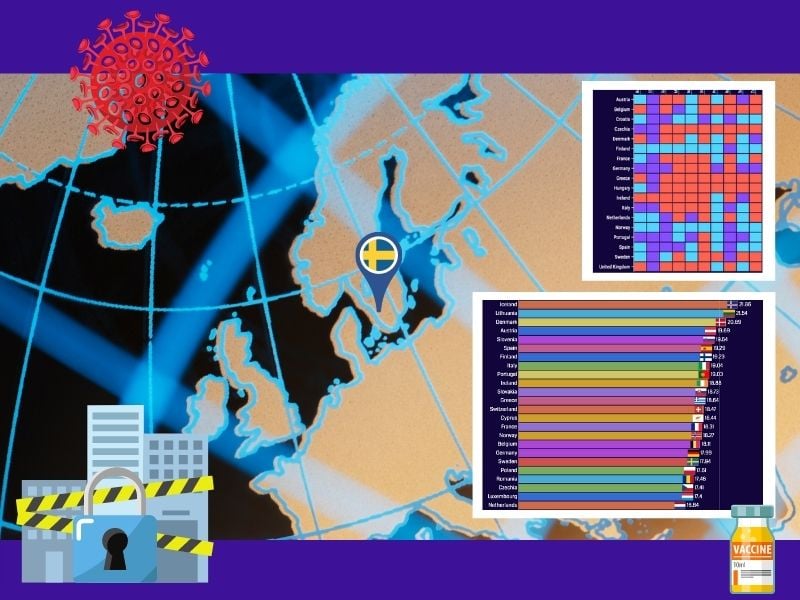
With the onset of spring and the delivery of millions of vaccines, Europe may seem as if it has reached the eve of the final phase of the COVID-19 pandemic. Yet, on a continental level, not only is the number of upper jabbed arms on the rise, but the number of infections is also still increasing in a lot of countries.
The differences in the various measures seem to widen day to day. Some countries are easing up with every passing day. While others are slamming the brakes on again. These measures – and the underlying strategies – feature in the main in this week’s instalment. As was the case six months ago, the leading role is played by the wayward Sweden: To what extent does their approach differ from the rest of us? What is going well? And what could be better? To get an answer to this, the measures of eighteen countries were compared with each other on ten different aspects.
That said, back to the current situation: What exactly are the figures? Firstly, the rollout of vaccines. In the weekly race animation it is easy to see that more and more countries are hitting the gas pedal. The animation below visualizes the number of shots per hundred citizens between December 29 and April 6.
Global vax pecking order

Like day and night
As the first country on the continent, Britain’s rapid injection efforts seem to be paying off. Rising vaccination rates, combined with a fairly strict lockdown, have ensured that the British have entered spring with such low infection rates. So much so that Boris Johnson is hinting at easing up on restrictions over the coming weeks.
Yet the microscopic tormentor has by no means disappeared. Hungary has the highest number of reported corona cases per 100,000 heads in the first week of April. But the situation in France is deteriorating the most rapidly of all. In the lion’s share of these countries on the heatmap, an upward trend can be spotted in the number of infections based on the weekly average.
To tighten up or to ease up? That’s the question
After a dire start to 2021 resulting in a long and gruelling lockdown, Portugal recorded the lowest number of new cases in all of Europe. This now makes what was January’s worst hotspot, the most corona-mild place on the continent after a punishing lockdown. As of this week, it is once more possible to visit a museum or enjoy a drink on a terrace there. The gates in the United Kingdom are also supposed to be reopening starting next week.
Although infection rates in the Netherlands are higher than in Portugal and the UK by a factor of ten and eight respectively, a new ‘road map to freedom‘ was announced here this week. With mandatory rapid tests at the entrance to amusement parks and soccer stadiums. And maybe even cafe and restaurant terraces should be able to open responsibly again sometime in April.
Nevertheless, elsewhere the reins are actually being tightened. Italy went on lockdown over the Easter weekend. Belgium and France introduced a four-week national lockdown. And Angela Merkel is also thinking aloud about following suit. Earlier this year, Sweden passed legislation that will make this possible there as well.
What are governments currently doing to contain the virus? Because the term ‘lockdown’ is anything but concrete, seventeen countries were compared on ten specific restrictions. It turns out that Greeks are allowed the least, Finns the most.
Is Sweden really that lenient?
With over 840,000 infections and 13,500 deaths, Sweden is a rather gray area in terms of epidemiology. Yet the country has been playing a very conspicuous role during the pandemic. After being the only one not to go into lockdown last year, many commentators, politicians and economists still seem to believe that this is still the case. Yet the European Centre for Disease Prevention and Control (ECDC) data shows something quite different. Many countries are “freer.” In Finland, for example, everything is open except for a ban on alcohol at an earlier time, and in Norway almost everything was possible until the end of March. Since a week and a half, some regional restrictions have been put in place there.
Sweden is taking things a lot further, as you can read on their official government website. While having a bite to eat with friends in a restaurant or entering a store without a face mask remains possible, any gathering of more than eight people are strictly forbidden. And do they make exceptions? No, they don’t.
As a consequence, museums, zoos and even all schools, among others, are closed for the time being. Anyone who disagrees with this and wants to demonstrate in the streets will be disappointed, because these kinds of protests are not allowed either. Those who want to roam the streets in protest together with hundreds of others, had better move to the Netherlands.
Nevertheless, there is something to be learned from the country with the highest third wave in Scandinavia, where relatively eight and ten times as many patients died as those in Norway and Finland respectively, which currently enjoy considerably more freedom. The fork in the road, according to the editor on duty, is a little different than you might think if you know the policy only from the castles in the air that were based on incomplete, gedateerde, erroneous ‘facts’.
Sweden has conceded that it is wrong on a multitude of fronts, but has been holding its ground since the beginning of the corona crisis where face masks are concerned, which have now surpassed the Danes as public enemy number one. The Swedes still consider a non-binding recommendation for public indoor spaces such as stores to be unnecessary. In fact, in some places they have even been banned.
Consistently the same rules for everyone
Is it all doom and gloom in Sweden? Absolutely not. The approach of the eccentric state epidemiologist Anders Tegnell can certainly be commended for its simplicity, consistency and clarity. In Sweden, it is primarily the phenomenon of ‘gatherings’ that is seen as the fundamental risk for spreading the coronavirus. Here it does not matter whether this gathering is in a church, school, city park or a living room. Since November, a group-of-eight limit has been in force here. This rule is easy to remember because it applies to everyone and everywhere. The only exception is funerals where twenty attendees are allowed.
This is not without reason. A major disadvantage of exemptions and special treatment is that by definition these also disadvantage other people or industries. Gatherings are allowed in parks? Then entrepreneurs in the hospitality sector will think that their terraces can be opened as well. The chance of such conflicts increases with every easing and tightening of the restrictions. After all, amended policies also lead invariably to aggrieved parties.
If someone feels that they have been disadvantaged enough, their trust in the government’s approach eventually ebbs away. This one ‘unjust’ sensitive chord can consequently also be the reason to comply less, or not at all, with the basic rules. Which only feel more complex due to the long list of ifs and buts. Because of the simplicity of the rules and the same-rules-for-everyone vision, the confidence of Swedish people in their government’s approach is relatively high.
By appealing to the collective sense of responsibility in which compliance is not only enforced by the authorities, but citizens also correct each other, more individual freedoms are allowed in smaller groups.
Best in class?
Does this ‘Swedish’ strategy also work in practice? It does for them! But actually it would be better to call it the ‘Scandinavian strategy’ and the biggest success story does not come from Sweden at all. It Scandinavian neighbours Norway, Finland and to a slightly lesser extent Denmark do more or less the same but with far fewer infection rates, deaths, restrictions and drama. But that Sweden “has the worst approach in Europe” is also not true either. If the hype around that approach didn’t exist, it would be a modest mid-tier player.
Scandinavians, with their generous collective welfare state, are among the happiest people on earth. They tend to have a strong sense of community, do not want to ‘make a scene’ and are more likely to obediently follow government advice. As a result, draconian measures and strict enforcement are less likely to be needed to get their population to comply.
This ‘laissez-faire’ approach to a pandemic would have led to dire apocalyptic scenes in countries with a more individualistic social mindset, such as the Netherlands and Britain, or ‘protest societies’ in which the government is distrusted by definition, such as France and the Czech Republic.
Did Sweden handle it all perfectly? No, not at all. But being thrown in the henhouse each week as an opinion crutch for charlatans who have been recycling the same fact-free claims for a year about policies from a corona-measure-free paradise that has long since ceased to exist is something that Sweden doesn’t deserve either.
Do you actually want to name a country that still has very few rules in place after all this time with a president who loves to hear that kind of lofty praise? Then consider Brazil, where nearly 20,000 corona deaths were reported in the past seven days.








